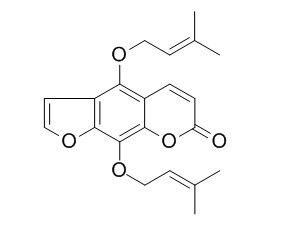Cnidicin
Cnidicin has anti-allergic and anti-inflammatory activity, it inhibits the degranulation of mast cell and the NO generation in RAW 264.7 cells(IC50 value, 7.5 microM). Cnidicin exhibits a significant inhibition on the proliferation of cultured human tumor cells such as A549 (non small cell lung), SK-OV-3 (ovary), SK-MEL-2 (melanoma), XF498 (central nervous system) and HCT-15 (colon) in vitro .
Inquire / Order:
manager@chemfaces.com
Technical Inquiries:
service@chemfaces.com
Tel:
+86-27-84237783
Fax:
+86-27-84254680
Address:
1 Building, No. 83, CheCheng Rd., Wuhan Economic and Technological Development Zone, Wuhan, Hubei 430056, PRC
Providing storage is as stated on the product vial and the vial is kept tightly sealed, the product can be stored for up to
24 months(2-8C).
Wherever possible, you should prepare and use solutions on the same day. However, if you need to make up stock solutions in advance, we recommend that you store the solution as aliquots in tightly sealed vials at -20C. Generally, these will be useable for up to two weeks. Before use, and prior to opening the vial we recommend that you allow your product to equilibrate to room temperature for at least 1 hour.
Need more advice on solubility, usage and handling? Please email to: service@chemfaces.com
The packaging of the product may have turned upside down during transportation, resulting in the natural compounds adhering to the neck or cap of the vial. take the vial out of its packaging and gently shake to let the compounds fall to the bottom of the vial. for liquid products, centrifuge at 200-500 RPM to gather the liquid at the bottom of the vial. try to avoid loss or contamination during handling.
Nutrients.2023, 15(12):2644.
Biochem Systematics and Ecology2017, 11-18
University of Limpopo2016, 1777
Processes2022, 10(10), 2008.
Kor.J.Herbol.2024, 39(3):23-35
Pharmaceuticals (Basel).2024, 17(9):1130.
Food Funct.2022, 13(14):7638-7649.
Cell J.2024, 26(8):496-504.
Front Immunol.2023, 14:1240800.
Aquaculture2017, 481:94-102
Related and Featured Products
Phytother Res. 2007 Mar;21(3):288-90.
Antiproliferative effect of furanocoumarins from the root of Angelica dahurica on cultured human tumor cell lines.[Pubmed:
17143927 ]
A bioassay-guided fractionation of the root extract of Angelica dahurica (Umbelliferae) led to the isolation of six furanocoumarins as active ingredients responsible for the antitumoral property.
METHODS AND RESULTS:
The hexane soluble part of the extract demonstrated a significant inhibition on the proliferation of cultured human tumor cells such as A549 (non small cell lung), SK-OV-3 (ovary), SK-MEL-2 (melanoma), XF498 (central nervous system) and HCT-15 (colon) in vitro, whereas the remaining water soluble part exhibited poor inhibition. Intensive investigation of the hexane soluble part of the extract yielded six furanocoumarins, i.e. isoimperatorin, Cnidicin, imperatorin, oxypeucedanin, byakangelicol, oxypeucedanin hydrate, all of which exhibited a significant inhibition on cell proliferation in a dose-dependent manner.
Planta Med. 2001 Mar;67(2):172-4.
Cnidicin, a coumarin, from the root of Angelica koreana, inhibits the degranulation of mast cell and the NO generation in RAW 264.7 cells.[Pubmed:
11301870]
Cnidicin (1) and five related coumarins were isolated from the root extract of Angelica koreana (Umbelliferae) as active principles responsible for the inhibitory effect on the degranulation process of cultured mast cells.
METHODS AND RESULTS:
Cnidicin (1) demonstrated a significant inhibition upon the release of beta-hexosaminidase from the cultured RBL-2H3 cells in a dose dependent manner (IC50 value, 25 microM) and upon the nitric oxide production from the activated RAW264.7 cells (IC50 value, 7.5 microM). In agreement with this, Cnidicin inhibited the expression of nitric oxide synthase in RAW264.7 cells.



